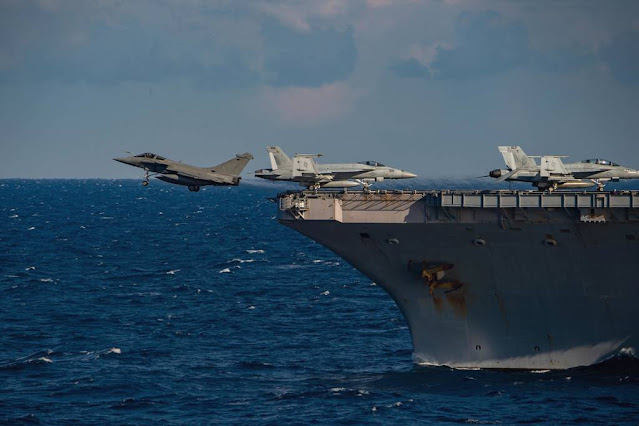French Navy, US Navy conduct dual carrier operations
 |
| French Navy Rafale F-3R launches from the flight deck of the Nimitz-class aircraft carrier USS Harry S. Truman (CVN 75). |
Starting in early February, the United States Navy's Carrier Strike Group 8 (CSG 8), focused on the USS Harry S. Truman (CVN-75) aircraft carrier and the French Navy's CSG, focused on the Charles de Gaulle (R91) aircraft carrier, have begun to operate jointly in the Mediterranean.
The two CSGs are carrying out complex activities involving more than 15 surface ships, submarines, maritime patrol aircraft and flight squadrons belonging to the two aircraft carriers. They are contributing to the defense of the eastern flank of the Alliance and to the control of the air-maritime space in the Mediterranean. Their mission is to strengthen NATO's situational awareness capabilities from the Central to Eastern Mediterranean as well as participate in NATO's enhanced Vigilance Activity (eVA) in Romania and Bulgaria.
The two CSGs are carrying out complex activities involving more than 15 surface ships, submarines, maritime patrol aircraft and flight squadrons belonging to the two aircraft carriers. They are contributing to the defense of the eastern flank of the Alliance and to the control of the air-maritime space in the Mediterranean. Their mission is to strengthen NATO's situational awareness capabilities from the Central to Eastern Mediterranean as well as participate in NATO's enhanced Vigilance Activity (eVA) in Romania and Bulgaria.
During the missions conducted so far, the two naval forces have demonstrated great interoperability and joint combat capabilities. Specifically, they shared information by connecting communication networks and tactical data links, deployed French and American aircraft on both aircraft carriers and in the same operational areas, and controlled maritime airspace in complex operations. The airwings of both nations also conducted air-to-air interactions of increasing intensity.
These various aircraft-to-aircraft trainings have mixed planes and crews, further enhancing their ability to operate together. The French and American landing officers exchanged positions on board the aircraft carriers to enable cross decks of the Rafale Marine, F/A-18 Super Hornet, French E-2C Hawkeye and American E-2D Advanced Hawkeye aircraft. For the first time, an E-2D performed landing presentations on the French aircraft carrier.
The proximity of the two CSGs also allowed the commanders of each CSG, each aircraft carrier and each air group to hold joint briefings, share their assessment of the tactical situation, and thoroughly coordinate their defense and surveillance positions.
This Dual Carrier operation has shown the fruits of the work done by both navies to achieve this high level of interoperability and mutual trust between the only forces in the world operating nuclear-powered CATOBAR aircraft carriers.
This Dual Carrier operation has shown the fruits of the work done by both navies to achieve this high level of interoperability and mutual trust between the only forces in the world operating nuclear-powered CATOBAR aircraft carriers.
Written by Darren Bondi
Images: US Navy, French Navy










No comments
All comments related to the contents of our articles are welcome. It is not allowed to post promotional messages, links to external sites, or references to activities not related to this blog.